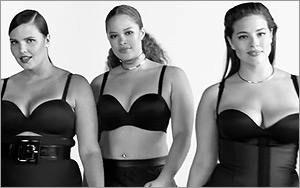apparel and retail
Un-Retouched Women: What Lingerie Can Teach Marketers Everywhere
- by Sarah Mahoney @mahoney_sarah, January 4, 2016

While it seems like it ought to be screamingly obvious by now — at least for anyone who’s ever watched one of the billion or so Dove-inspired “real-women” videos — women are actually real. (All of them! Not just the ones in the videos!) And they like it when marketers show them women who look real, too.
But a quick scan of the 10-most read stories in the retail and fashion beats this year makes us think that “This is what women really look like!” concept is still kind of newsy. So let’s start with the most-read story, about a beautiful ad campaign for a new line of Lane Bryant lingerie, an unapologetic launch for plus-size women.
advertisement
advertisement
Although some two-thirds of adult American women are overweight, it has long been treated as a niche market. So it’s no surprise that the campaign, which features a collection of glamorous and decidedly sexy models who aren’t ashamed to strut in their dainties, was read and shared so much.
A little more surprising, though, is that two more of the year’s most-read stories are about an entirely different demographic trying to capture that sexy-confident swagger: Aerie, the lingerie brand of teen retailer American Eagle, timed a new #AerieReal bikini campaign to spring break, but instead of the predictable Girls Gone Wild vibe that has made millions of young women feel bad about their bodies, it opted for a social-media effort that asked women to upload “body positive” photos. It even included a publicity stunt billed as the world’s largest un-retouched selfie. The campaign was so body-positive, in fact, that it earned a first-ever “Seal of Approval” from the National Eating Disorders Association, also generating one of the year’s most read stories.
And the real fitness needs of women trying to become stronger, fitter and faster also fueled a piece about how — and why — sports apparel challenger Under Armour is trying to reach women through digital channels and connected fitness.
It’s also clear that readers are eager to learn more about the ways retailers and brands can work together to use mobile more effectively, including a piece about Forrester Research’s take on the way mobile is emerging as an anti-channel, how Walgreen’s, Home Depot, L’Oreal and Sephora are acing mobile, and how Target is using mobile to change its relationships with both Millennials and Hispanics.
Finally, readers were also intrigued with a massive freebie day used by Planet Fitness, as well as a study showing that college kids are stepping away from once-favorite brands like Ugg, Timberland and Michael Kors.


